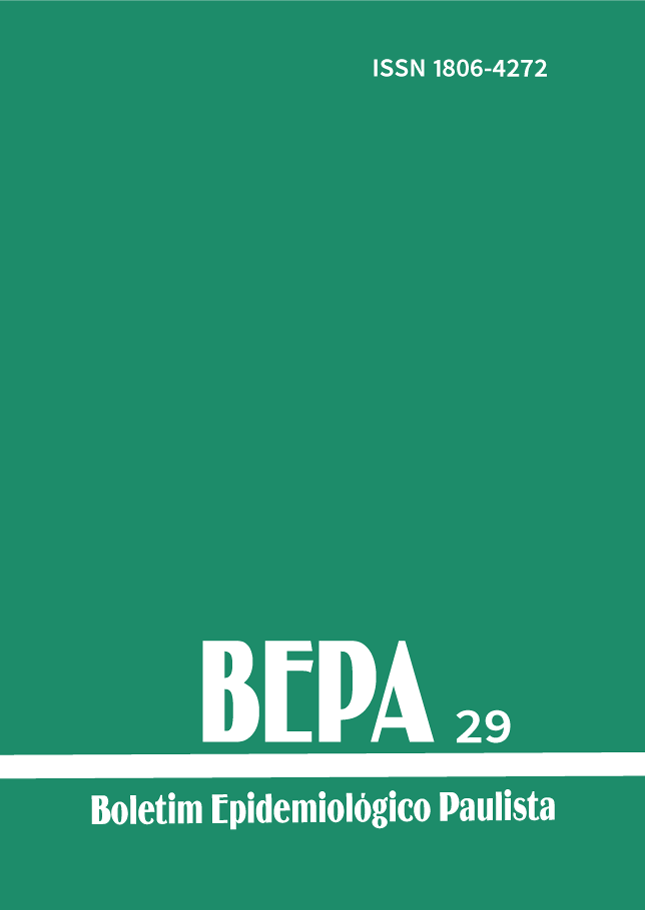Abstract
Starting with the registers of deaths caused by human rabies, confirmed by laboratory, in the period from 1970 to 2002, collected by the Pasteur Institute, a retrospect clinical and epidemiological study was performed. Regarding the state from which each case came from, it was possible to see that 85% were of the state of São Paulo. Distribution according to sex showed that 74,9% were males and 25,1%, females; age criteria showed that 38,4% of the deaths occurred in people under 10 years of age. The study showed that dogs were responsible for 91,3% of the cases, and the majority of the aggressive animals disappeared or was “ignored”, and bites were the most reported form of aggression. Minimum incubation period was 10 days and the longest period registered in this study was 715 days. Average incubation period was 73 days, with the median established in 54 days. In 54,2% of the cases, the aggression hit the head or superior members, and in 35% there was a single superficial lesion. Average period for the evolution of the disease was six days and most related symptoms were hydrophobia, aerophobia, fever and behavior changes.
References
Rupprecht CH; Hanlon CA; Hemachudha T. Rabies re-examined. Lancet Inf Dis 2002; 2: 327-43.
[OPAS] Organización Panamericana de la Salud. Boletín Vigilancia Epidemiologica de la Rabia en las Américas. PANAFTOSA, Rio de Janeiro. v. XXXII, 2000; 40p.
[OPAS] Organización Panamericana de la Salud. Boletín Vigilancia Epidemiologica de la Rabia en las Américas. Rio de Janeiro, PANAFTOSA. v. XXXIII 2001; 40p.
[OPAS] Organización Panamericana de la Salud. Boletín Vigilancia Epidemiologica de la Rabia en las Américas. Rio de Janeiro, PANAFTOSA. v. XXXIV 2002; 40p
Jackson AC. Pathogenesis: Rabies. San Diego: Academic Press; 2002. p. 246-274.
Acha PN; Szyfres B. Zoonosis y enfermedades transmissibles comunes al hombre y a los animales. 3 ed. Washington, DC. Organización Panamericana de la Salud, 2003. V.2, 425p.
Lafon M. Rabies virus receptors. J Neuro Virol 2005; 11:82-7.
Centers Disease Control-CDC Investigation os rabies infections in organ donor and transplant recipients – Alabama, Arkansas, Oklahoma, and Texas, 2004. Morb Mortal Wkly Rep. 2004;
Honhold N. Rabies, human, organ transplantation-Germany. Disponível em [2005 fev 25].
Jackson AC. Human Disease: Rabies. San Diego:Academic Press; 2002. p.219-244.
Willoughby Jr RE; Tieves KS; Hoffman GM; Ghanayem NS; Amlie-Lefond CM; Schwabe MJ; Chusid MJ et al. Survival after treatment of rabies with induction of coma. N Engl J Med. 2005; 352:2508-14.
Kotait I; Favoretto SR; Carrieri ML; Takaoka NY. Raiva humana causada pela variante-3 Desmodus rotundus – no Estado de São Paulo. In: Seminário Internacional Morcegos como Transmissores da Raiva; 2001 dez 3-6; São Paulo, 2002. p.70.
Warrel MJ & Warrel DA. Rabies and other lyssavirus diseases. The Lancet. 2004; 363: 959-69.
Veeraraghavan N; Gajanana A; Oonnunnii PT; Saraswathi K; Devaraj JR. Neutralizing antibody levels in natural and experimental rabies infection. Scient Rep Pasteur Inst Sth India. 1972; p.83-90.
Nilsson MR. Revisão do conceito de que raiva é sempre fatal. Bol Oficina Sanit Panam. 1970; 68:486-97.
Fekadu M; Shaddock JH; Baer GM. Intermittent excretion of rabies virus in the saliva of a dog two and six months after it had recovered from experimental rabies. Am J Trop Med Hyg. 1981; 30:113-5.
Hattwick MA & Gregg MB. The disease in man. In: Baer GM. The natural history of rabies. New York, Academic Press, 1975. p.281-304.
Baer GM e Lentz TL. Rabies pathogenesis to the central nervous system: The Natural History of Rabies. 2nd ed. Boca Ratón: CRC Press; 1991.p.106-118.
Campillo-Sainz C; Múgica CMC; Izquierdo AE; Lombardo L; Salido F. La rabia humana en México. Gac Med Mex. 1980; 116:517-33
Anand AC, Choudhary M; Nrayana VA; Dhar SR; Gangully SB. Hydrophobia in a case of viral hepatitis. J Assoc Physicians India. 1986; 34:294-6.
Sang E; Farr RW; Fisher MA; Hanna SD. Antemortem diagnosis of human rabies. J Fam Pratice. 1996; 43:83-7.
Guinto G; Felix I; Rivas A. Un caso de encefalitis rábica de larga evolución: correlación clinico patologica. Gac Méd Mex. 1986; 131:223-8.
Luna GL; Chahuayo LM; Marreros AT. Diez casos de rabia humana em Pucallpa: enero-agosto 1984. Diagnostico. 1985; 15:156-60.
Kureishi A; Xu LZ; Wu H; Stiver HG. Rabies in China: Recommendations for control. Bull WHO. 1992; 70:443-50.
Schneider MC; Almeida GA; Souza LM; Morares NB; Diaz RC. Controle da raiva no Brasil de 1980 a 1990. Rev Saúde Pública. 1996; 30:196-203

This work is licensed under a Creative Commons Attribution 4.0 International License.
Copyright (c) 2006 Maria Luiza Carrieri, Neide Yumie Takaoka, Ivanete Kotait, Pedro Manuel Leal Germano
